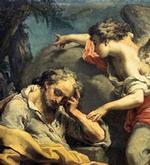Catholic Activity: St. Lucia Devotions
December 13, the feast of St. Lucia (or Lucy), brings many traditions from both Italy and Scandinavian countries. The author describes a few of these customs.
DIRECTIONS
With Catherine and Barbara, Lucy or Lucia is one of the three great "girl saints." She died during the persecutions of Diocletian at Catania in Sicily, being beheaded by the sword. Her body was later brought to Constantinople and finally to Venice, where she is now resting in the Church of Santa Lucia.
Because her name means "light" she very early became the great patron saint for the "light of the body" — the eyes. All over Christianity her help was invoked against diseases of the eyes, especially in danger of blindness. This is the reason why she is often pictured with a plate in hand on which lie two eyeballs. The lighters of street lamps in past centuries had her as patron saint and made a special ceremony of their task on the eve of December 13. She also is the patron of the gondoliers in Venice, whose familiar song, "Santa Lucia," is an affectionate tribute to her.
Saint Lucy attained immense popularity in medieval times because, before the calendar reform, her feast happened to fall on the shortest day of the year. Again because of her name, many of the ancient light and fire customs of the Yuletide became associated with her day. Thus we find "Lucy candles" lighted in the homes and "Lucy fires" burned in the open. In Scandinavia before the Reformation Saint Lucy's Day was one of unusual celebration and festivity because, for the people of Sweden and Norway, she was the great "light saint" who turned the tides of their long winter and brought the light of day to renewed victory.
This is the reason why her lore has survived in the Scandinavian countries even after the Reformation and calendar reform, which brought the solstice back to December 23. In Sweden and Norway it is still a custom on December 13 for a girl in a white dress (representing the Saint), with a wreath on her head in which burning candles are placed, to awaken the family from sleep and offer a tray with coffee and cakes. The impersonation is called Lussibrud (Lucy bride) and her pastry is Lussekattor.
Another popular custom in Scandinavia on the eve of December 13 is for children to write the word "Lussi" on doors, fences, and walls. With the word always goes the picture of a female figure (Saint Lucy). The purpose of this practice in ancient times was to announce to the demons of winter that their reign was broken on Saint Lucy's Day, that the sun would return again and the days become longer.
"Lucy Fires" used to be burned everywhere in northern Europe on December 13. Into these bonfires people threw incense, and while the flames rose, trumpets and flutes were played to greet the changing of the sun's course. These fires were greatly valued as a powerful protection against disease, witchcraft, and dangers, and people would stand nearby and let the smoke of the incense reach them, thus obtaining the desired "protection."
After the calendar reform, when the original reason for such celebrations (the solstice) was gradually forgotten, Lucy's figure degenerated into a winter demon in many sections of Europe. In Sweden and Norway, however, the ancient meaning of the feast was essentially preserved and Lussi always remained a friendly, cheerful figure. Thus the attractive little martyr and great Saint of the Middle Ages has kept her name and her role as "light bringer" in Scandinavia, although most people today are unaware of the historical background and true meaning of this part of their folklore. In the liturgy of the Church, Saint Lucy has held, and still holds today, the inspiring position of a saint whose very name reminds the faithful at the middle of Advent that her own "light" is only a reflection of the great "Light of the World" which is to start shining at Bethlehem on Christmas Day. It is as if she would say: "I am only a little flame in Advent showing you the way:
Behold, the Lord will come And all His saints with Him, And on that day There will be a great light. Alleluia.LITURGICAL PRAYER: Hear us, O God, our salvation, as we rejoice on the feast of Saint Lucy, Thy virgin and Martyr, and grant us to learn the spirit of pious devotion.
Activity Source: Holyday Book, The by Francis X. Weiser, S.J., Harcourt, Brace and Company, Inc., New York, 1956






